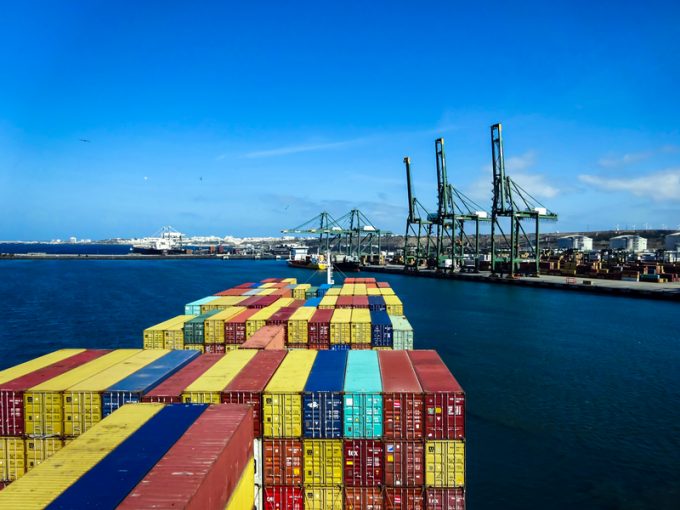Container spot rates have peaked as all major trades see prices fall
There was more evidence in this week’s container port freight markets that peak prices on ...
TFII: SOLID AS USUALMAERSK: WEAKENINGF: FALLING OFF A CLIFFAAPL: 'BOTTLENECK IN MAINLAND CHINA'AAPL: CHINA TRENDSDHL: GROWTH CAPEXR: ANOTHER SOLID DELIVERYMFT: HERE COMES THE FALLDSV: LOOK AT SCHENKER PERFORMANCEUPS: A WAVE OF DOWNGRADES DSV: BARGAIN BINKNX: EARNINGS OUTODFL: RISING AND FALLING AND THEN RISING
TFII: SOLID AS USUALMAERSK: WEAKENINGF: FALLING OFF A CLIFFAAPL: 'BOTTLENECK IN MAINLAND CHINA'AAPL: CHINA TRENDSDHL: GROWTH CAPEXR: ANOTHER SOLID DELIVERYMFT: HERE COMES THE FALLDSV: LOOK AT SCHENKER PERFORMANCEUPS: A WAVE OF DOWNGRADES DSV: BARGAIN BINKNX: EARNINGS OUTODFL: RISING AND FALLING AND THEN RISING

There was another significant fall in transpacific container spot rates, as recorded on Friday by the Shanghai Containerized Freight Index (SCFI), just as the new contract season negotiations kicked off.
The US west coast component of the SCFI fell 7.6% to $1,431 per 40ft, while spot rates for US east coast ports fell 6.1% to $2,479 per 40ft.
Since November, spot rates on the transpacific tradelane have fallen by 48% for the US west coast and by 35% for US east coast ports, when carriers’ revenue was boosted by strong demand from the front-loading of cargo ahead of US tariff hikes on Chinese imports.
Many BCOs sat down with their carriers at last week’s JOC TPM conference in Long Beach to begin preliminary talks on volumes and rates, but there was a sense that the shipping lines were struggling to convince their customers they should pay more.
Indeed, one large BCO told The Loadstar he intended to “sit on his hands” and see how the next few weeks played out.
“They are all keen to see me here and have some lunch; I wonder why,” he said.
Unsurprisingly, with weak demand exacerbated by the front-loading, ocean carriers are scrambling to blank sailings on the route to halt the spot rate slide.
For example, according to Alphaliner data, the members of the Ocean Alliance, CMA CGM (including APL), COSCO (including OOCL) and Evergreen, will cancel 10 transpacific headhaul sailings this month and next, removing 74,180 teu of capacity from the US west coast and 35,620 teu of slots for the US east coast.
The consultant said the blanked sailings represented around 15% of the capacity the alliance was scheduled to offer over the four-week period of the cancellations.
It is understood that both the 2M and THE alliances will shortly announce their transpacific blanking programmes to mitigate the soft outlook.
Commenting on the January Container Trade Statistics (CTS) data for January during a TPM presentation last week, Lars Jensen, CEO and partner at SeaIntelligence Consulting, said the CTS number for US import growth at 3.7% “was not a very impressive figure”, given the earlier fall of Chinese new year this year, compared with 2018.
He said: “A reasonable reading of this would be it shows the effect of the pre-tariff front-loading in Q4 18, which will inevitably act as a dampener on growth in Q1 and possibly even Q2 of 2019.”
Meanwhile, Asia-Europe carriers are also fighting to arrest decline in their spot rate market, which now accounts for over 50% of the containers moved on the route.
The SCFI recorded a further 5.3% drop in spot rates from Asia to North Europe to $754 per teu, and a 4.2% fall in rates to Mediterranean ports to $776 per teu.
CTS data shows an impressive 8.6% year-on-year growth for European imports in January, which is supported by performance data released by Ocean Network Express (ONE) showing a 99% utilisation level on its Asia Europe headhaul services in the same month.
Given the strong data, it is unclear exactly what is driving rates down on the tradelane – other than carriers starting to panic due to disappointing forward bookings.
One carrier explained to The Loadstar, on the side lines of the TPM conference, that its visibility on bookings was roughly four weeks and that contracts on the Asia-Europe route were now shorter in duration, with many agreed for three months or less.
This he said was why keeping spot rates stable was as important as signing new contracts.
Comment on this article